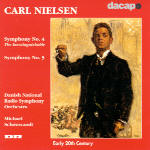Carl Nielsen’s last three symphonies operate on many levels, and perhaps this is why they have proven to be so elusive on disc. Many a great conductor has crashed on the Inextinguishable’s treacherous rocks, missing the music’s vital current and getting bogged in down in leaden tempos. Leonard Bernstein made the mistake of reading an unnecessary melancholy into Nielsen’s soaring melodies, while Herbert von Karajan seems to have been the victim of a cruel hoax–someone replaced the title page of his score with the name “Bruckner”. Truly successful performances have been few. Among these are Jean Martinon’s galvanizing rendition with the Chicago Symphony and Paavo Berglund’s with the Royal Danish Orchestra, both on RCA, and Alexander Gibson’s dynamic, superbly recorded account on Chandos with the Scottish National Orchestra.
This new recording on Dacapo by Michael Schonwandt and the Danish National Radio Symphony now joins this exclusive club. Schonwandt’s winning interpretation reflects a profound identification with Nielsen’s idiom, and under his baton the music issues forth as naturally as breathing. From the jagged opening notes, to the first climax of the work’s motto theme, to the jousting development section, Schonwandt imparts a sense of inevitability to Nielsen’s most dramatic symphonic first movement and has his players keenly attuned to its many facets. While the following two movements are just as insightful and accomplished (with beautiful wind playing in the second and eloquent strings in the third), the finale is the champion of this performance. Not since Martinon’s 1960s reading has the epochal timpani battle been so clearly delineated and blazingly realized. The orchestra also is on top of Nielsen’s dizzying polyrhythmic sequences, and somehow manages to project all of them distinctly. And at last the symphony ends in a triumphant sunrise, unmitigated by Tomfoolery with Nielsen’s clearly notated tempo and dynamics.
The great Fifth Symphony is more straightforward rhythmically, but scarcely less difficult to bring off. Many conductors seem to have trouble negotiating the subtle relationship between the two halves of the first movement, or else they treat the finale as if it were a symphony all its own. For decades, Bernstein’s Sony recording with the New York Philharmonic held pride of place, and this newcomer is one of the very few able to withstand comparison with that classic version. Again, the magic is in the details–the ideally balanced woodwind and percussion in the opening movement’s first half, the stoic yet moving reading of the big string tune in the second half (beautifully accented by the winds), and the perfectly placed snare drum solo at the movement’s end. The only slight caveat, as usual, is the climactic improvised snare drum cadenza, which is certainly one of the better ones (and arguably the most attentive to Nielsen’s directions for the player to pause briefly between onslaughts), but that still doesn’t top Horenstein’s manic conception, rim shots and all.
There are thrills aplenty in the finale, however. Schonwandt’s basic tempo gives this airborne music room to spread its wings without getting weighed down like Horenstein’s heavy-handed, “spruce goose” of a reading. As with the Fourth Symphony, Schonwandt’s characterful exploration of Nielsen’s orchestral textures makes the music sound wonderfully vital and dynamic. Check out the lovingly hushed string playing following the wild first fugue episode, or the spine-tingling entry of the woodwinds against the leaping brass octaves in the pages leading to the final peroration. Attentive listeners will note some unusual notes and orchestration at various points, as Schonwandt mostly utilizes the New Critical Editions of both scores (he retains some traditional passages where there is a choice between versions sanctioned by the composer). In sum, these performances stand as the best modern recordings of these symphonies available, and
Dacapo’s engineers capture them in a wonderfully realistic and natural acoustic. [7/25/2000]
































